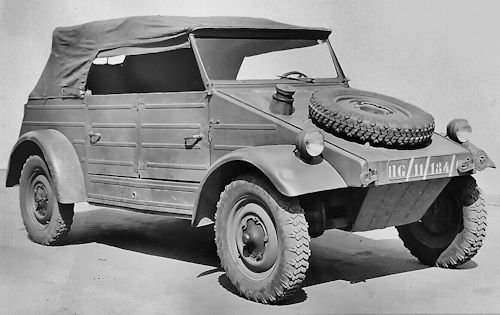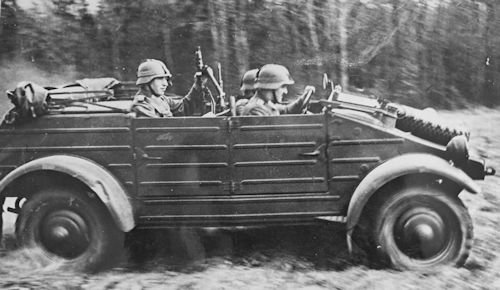VW Kübelwagen Type 82
 |
|
|
Model: |
Kübelwagen |
|
Production period: |
1940 to 1945 |
|
Class : |
Military |
|
Body versions : |
Various |
|
Engines: |
Gasoline: 1.0-1.1 liters (17,5-18 kW) |
|
Length: |
3740 mm |
|
Width: |
1600 mm |
|
Height: |
1110-1650 mm |
|
Wheelbase : |
2400 mm |
|
Curb weight : |
715-1160 kg |
The as Kübelwagen designated VW type 82 is based on the KDF-carriage constructed motor vehicle of the armed forces . From August 1940 to April 1945, the Volkswagen factory at Fallersleben produced 50,788 pieces in various designs. After the end of the war, the Type 82 was for a short time unchanged as Type 21 referred to remaining parts.
History
After the outbreak of World War II and the concomitant reorientation of the economy in the National Socialist German Reich on the production of military equipment derived from the KdF car off-road vehicle was built. The Type 82 was with total of pieces 50,788 built from 1940 to 1945 unnecessarily with minor changes. The Type 82 is an open, edgy car with fabric top and front windable windshield. It has four doors and can accommodate four people. The spare wheel is located on the sloping front end, in which there is also an accessible compartment for a jerrycan. The trunk is between the rear seats and the engine
At the suggestion of the Army Weapons Office , Porsche KG began in 1938 with the further development of the KdF car for military purposes. The Army Weapons Office laid down the following requirements: open body, total weight 950 kg (vehicle 550 kg + 400 kg for three men with equipment), low height, possibility of large-scale production with the lowest possible development costs. Furthermore, emphasis was placed on minimum material and production costs. At the end of 1939, the first prototypes of the new off-road vehicle with the angular body were the Type 62 completed. The production of civilian "KdF cars", originally planned for hundreds of thousands of Germans through a savings contract, was abandoned: the use of the Volkswagen plant for armaments production due to the outbreak of war meant the end of the plans for production of the civilian version of the car. The serial production of the VW beetle began only after the war.
After further test drives and modifications to the Type 62, which included a shaft for higher ground clearance and greater wheel torque, the Wehrmacht High Command (OKW) was satisfied with the vehicle and the final vehicle was designated Type 82 . After the first cars were manufactured until the end of June 1940 at Porsche in Stuttgart, began on 3 August 1940, the series production in the Volkswagen factory. The bodies VW did not build itself, but they were delivered in Ambi-Budd from Berlin and painted in the factory. Since the foundry was not yet operational, VW took the castings from the company Rautenbach (Rautal-Werke GmbH) in Wernigerode . At the same time started the development of a version with all-wheel drive , the later type 87 .
In the field, the benefits of the type 82 showed its low weight and the 23.5 hp were with 985 cc displacement engine. Even without four-wheel drive, this was able to drive through difficult terrain. Other advantages were the air cooling , with the car was not dependent on replenishment of water and (in winter) antifreeze. During the course of the war, it became apparent that it could also be used under extreme climatic conditions, such as in North Africa in the Afrika Korps or in Russian winter. In 1943, the 985 cc engine for a stronger type 166 Schwimmwagen further developed 1131 cc engine with 24.5 hp replaced the smaller version. On the basis of the type 82, several variants, modifications and combinations of individual models were developed and built, for example the type 92 flatbed, the type 174 storm boat with VW engine and the type 287 command car. The top speed was about 80 km / h. The production of the wagon ended on April 10, 1945; in the following days American troops occupied the factory.

Technical
-
Technology
- Air-cooled four-cylinder four-stroke boxer engine with 985 cc and 23.5 hp (17 kW). From March 1943 cm³ with 1131 displacement and 25 hp (18 kW), just lying behind the rear axle
- Unsynchronized four-speed gearbox, 1st and 2nd gear with straight-toothed sprockets (higher noise, but less power loss), 3rd and 4th gear helical (quieter) with pin circuit
- Rear-wheel drive with automatic locking differential with crown wheels and sliding blocks
- Front axle: Independent wheel suspension ( crankshaft anchor axle , front axle body with two crankshaft core each and torsion bar suspension with leaf spring packs), steering with spindle and nut segment; The nut only engages from above into the steering spindle.
- Rear axle: Portal - swing axle , guided on trailing arms with transverse torsion bars. The spur gears (Z1: Z2 = 15:20) on the wheels give more ground clearance, higher wheel torque and lower speed.
- 6-volt electrical system with DC generator 130 watts
- Drum brakes on all wheels operated via cables without length compensation
- Maximum speed about 80 km / h
-Note: More Specifications and Repair Manuals available for registered users-
© Motor car History
Manuals
-
Volkswagen Previous 53 / 53 Next
